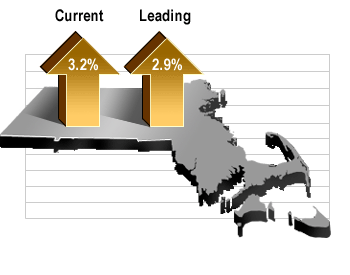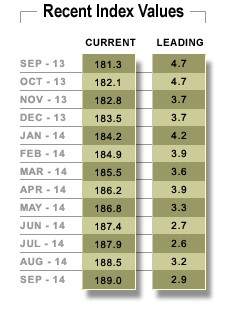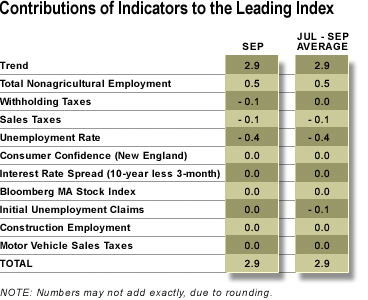Massachusetts Economy Expands Moderately in Q3, UMass Journal Reports
Near-term outlook is for continued growth
September 2014
 Massachusetts real gross domestic product grew at an estimated annualized rate of 3.2 percent in the third quarter according to the MassBenchmarks Current Economic Index, released today by MassBenchmarks, the journal of the Massachusetts economy published by the UMass Donahue Institute in collaboration with the Federal Reserve Bank of Boston. U.S. real domestic product grew at an annual rate of 3.5 percent during the same period according to the advance estimate of the U.S. Bureau of Economic Analysis.
Massachusetts real gross domestic product grew at an estimated annualized rate of 3.2 percent in the third quarter according to the MassBenchmarks Current Economic Index, released today by MassBenchmarks, the journal of the Massachusetts economy published by the UMass Donahue Institute in collaboration with the Federal Reserve Bank of Boston. U.S. real domestic product grew at an annual rate of 3.5 percent during the same period according to the advance estimate of the U.S. Bureau of Economic Analysis.
State and national growth slowed a bit in the third quarter following more robust growth in the second quarter and negative growth in the first. Based on the latest available information, we now estimate that in the second quarter the Massachusetts economy expanded at a 4.8 percent annualized rate as compared to the Bureau of Economic Analysis' final estimate of 4.6 percent for the nation. In the first three months of 2014, we estimate that economic activity declined at a 2.4 percent annual rate here in Massachusetts and declined at a 2.1 percent annualized rate nationally.
"After a weak weather-affected first quarter and the rebound in the second quarter, both the Massachusetts and U.S. economies seem to have returned to moderate growth, with some inconsistent signs of acceleration in growth," noted Alan Clayton-Matthews, MassBenchmarks Senior Contributing Editor and Associate Professor of Economics and Public Policy at Northeastern University, who compiles and analyzes the Current and Leading Indexes.
The job market has continued to improve in recent months, despite a temporary decline in retail employment in August due to the Market Basket disruption. Payroll employment in Massachusetts grew at a 2.0 percent rate in the third quarter, and was 1.8 percent higher than the third quarter of last year. U.S. payroll employment also grew 2.0 percent in the third quarter and was 1.9 percent higher than the third quarter of last year. For both the state and the nation, this reflects a slight acceleration in the pace of job growth.
 Labor earnings and spending have kept pace with job growth in Massachusetts. As estimated by withholding tax revenues, wage and salary income grew at an annual rate of 9.2 percent in the third quarter and was up 6.1 percent on a year over year basis. Spending on items subject to the regular sales tax and motor vehicle sales tax grew at an annual rate of 1.0 percent in the third quarter, and was up 5.7 percent from the third quarter of last year.
Labor earnings and spending have kept pace with job growth in Massachusetts. As estimated by withholding tax revenues, wage and salary income grew at an annual rate of 9.2 percent in the third quarter and was up 6.1 percent on a year over year basis. Spending on items subject to the regular sales tax and motor vehicle sales tax grew at an annual rate of 1.0 percent in the third quarter, and was up 5.7 percent from the third quarter of last year.
The state's unemployment rate rose from 5.5 percent in June to 6.0 percent in September, just above the U.S. rate of 5.9 percent. However, this modest rise in the unemployment rate does not signal a weakening labor market. Rather, it appears that workers are gaining confidence in the economy and are entering or reentering the labor force in greater numbers. In the third quarter, the state's labor force was 16,900 higher than in the second quarter, an annualized rate of increase of 1.9 percent.
Despite a relatively sluggish global economy, year to date (through August) Massachusetts merchandise exports have grown at a 5.3 percent annual rate, as compared to 3.3 percent for U.S. merchandise exports. U.S. production of information processing and related equipment, a reliable indicator of conditions in the information technology sector, expanded at an annual rate of 5.8 percent in the third quarter and by 1.8 percent on a year-over-year basis.
The MassBenchmarks Leading Economic Index for September was 2.9 percent, and the three-month average for July through September was 2.9 percent. The leading index is a forecast of the growth in the current index over the next six months, expressed at an annual rate. Thus, it indicates that the economy is expected to grow at an annualized rate of 2.9 percent over the next six months (through March 2015).
 The 10 indicators that comprise the leading index usually do not all move in tandem. Typically, some may indicate an expectation of faster than average growth, while at the same time others may indicate an expectation of slower than average growth. The following table accounts for the contributions of each towards faster or slower growth than the trend of 2.9 percent. The index value is their sum.
The 10 indicators that comprise the leading index usually do not all move in tandem. Typically, some may indicate an expectation of faster than average growth, while at the same time others may indicate an expectation of slower than average growth. The following table accounts for the contributions of each towards faster or slower growth than the trend of 2.9 percent. The index value is their sum.
In September, one indicator, total nonagricultural employment, contributed to a forecast of above-trend growth. Six indicators contributed to average-trend growth: consumer confidence, the interest rate spread between 10‑year and 3‑month U.S. Treasury securities, the Bloomberg stock index for Massachusetts, initial unemployment claims, construction employment, and motor vehicle sales taxes. Three indicators contributed to below-trend growth: withholding taxes, sales taxes, and the unemployment rate.
In the three-month period July through September, one indicator, total nonagricultural employment, contributed to a forecast of above-trend growth. Six indicators contributed to average-trend growth: withholding taxes, consumer confidence, the interest rate spread between 10‑year and 3‑month U.S. Treasury securities, the Bloomberg stock index for Massachusetts, construction employment, and motor vehicle sales taxes. Three indicators contributed to below-trend growth: sales taxes, the unemployment rate, and initial unemployment claims.
The current and historical quarterly estimates for state domestic product growth include adjustments for changes in productivity growth. These adjustments are estimates of the quarterly deviations from trend in the growth of the ratio of output to employment and output to wage and salary income. In the third quarter of 2014, these adjustments subtracted 0.3 percentage points from the annualized rate of growth. In the second quarter of 2014, these adjustments added 0.5 percentage points to the annualized rate of growth. In the first quarter, these adjustments subtracted 7.1 percentage points from the annualized rate of growth. For the forecast of state domestic product growth in the fourth quarter of this year and the first quarter of next year, productivity growth is assumed to return to its trend.
Several recent months of the indices are revised each release. These revisions are a result of the statistical method used to create the index, as well as revisions in the underlying indicators.
--------
All of the indicators except interest rates refer to Massachusetts. The current index is composed of four indicators: nonagricultural employment, withholding taxes, sales taxes, and the unemployment rate. The leading index includes these four current indicators plus the other six (leading) indicators in the contributions table. All of the indicators are as of September, except for interest rates and the Bloomberg stock index for Massachusetts, which are through October 27th. The MassInsight Consumer Confidence Index is released every third month. Intervening months are interpolated, and changes in the Conference Board's Consumer Confidence Index for the U.S. are used to extrapolate to the current month of the index, as needed. Series measured in current dollars or values, i.e., withholding taxes, sales taxes, the Bloomberg stock index, and motor vehicle sales taxes, are deflated by the U.S. consumer price index for all urban consumers, excluding food and energy.
For a description of the methodology used to construct these indices, see: Alan Clayton-Matthews and James H. Stock, "An application of the Stock/Watson index methodology to the Massachusetts economy," Journal of Economic and Social Measurement, vol. 25 (1998/1999), pp. 183-233.
Dr. Alan Clayton-Matthews
MassBenchmarks
Northeastern University, School of Public Policy and Urban Affairs
October 30, 2014

